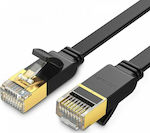Let me start with some comments regarding wifi repeaters/ extenders, as the differences between them and wifi mesh/ access points were initially unknown to me and I had to research the topic extensively:
The following are the main characteristics of repeaters/ extenders compared to wifi mesh/ access points:
- Most of them do not have the ability to be wired to an existing wired network. This means that they need to be placed where there is at least a moderate wifi signal strength in order to extend it, thus significantly limiting options in larger spaces.
- Each repeater creates its own wifi network (with a different name from the router), resulting in some mobile devices not automatically switching to the stronger network. For example, while moving away from the router's area to the area covered by the repeater, the mobile device will not switch to the repeater's stronger network unless it loses the router's signal. (Despite my Samsung phone having intelligent wifi function for automatic switching to the stronger network, it did not work in practice). With wifi mesh/ access points, you have one network throughout the space.
- On the positive side, most repeaters can simply be plugged into an outlet without the need for extra power cables.
Now let's specifically discuss the comments about the Halo H30G:
The manufacturing company belongs to TP LINK and they have the same technical support phone number, which was friendly and helpful when I called them. I chose them over similar products from the parent company due to the cost difference. They are small, visually appealing, and lightweight.
The installation as wireless access points seems particularly easy.
On the contrary, the installation as wired access points was troublesome for me, as well as for another reviewer with the Halo H50G. Perhaps this is due to my lack of experience in this area, but regardless, I expected the installation to be more user-friendly.
Do not upgrade the firmware on any unit by itself. Upgrade all of them together. In my case, the third unit with old firmware was not recognized by the network of the other two units that I had upgraded. I solved this by deleting the network of the two units and starting a new network with the unit with old firmware in order to upgrade it as well. The manufacturer provides instructions for upgrading firmware on individual units, but I was not able to apply them.
Contrary to the manufacturer's instructions that in wired access point mode, all units can be directly connected to the router, this connection did not work for me. In order for it to work, the two satellites had to be connected to the central unit (via a switch) and the central unit had to be directly connected to the router (and with another cable to the switch that provides wired internet to all outlets, including the outlets that provide internet to the satellites).
One satellite unit must be initially connected wirelessly (where the wifi signal is strong) and then it can be moved to wherever we want with a wired connection (where there is no wifi signal at all, which was my case).
I renamed the new wireless network created by the Halo H30G (3-pack) to my old network (same name and password), which I disabled from the router. The existing devices automatically connected without a new setup.
After spending 2-3 hours experimenting and burning calories up and down stairs, it eventually works flawlessly with speeds that almost reach the nominal speeds of my internet provider. Considering that my inconvenience is due to my own inexperience and since the devices work as they should, I gave 5 stars. Good luck!
























































